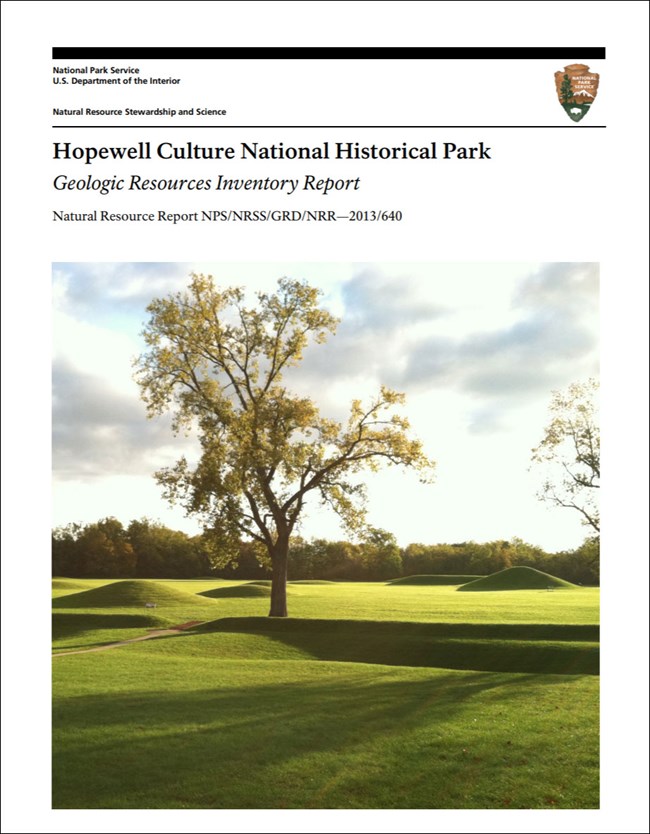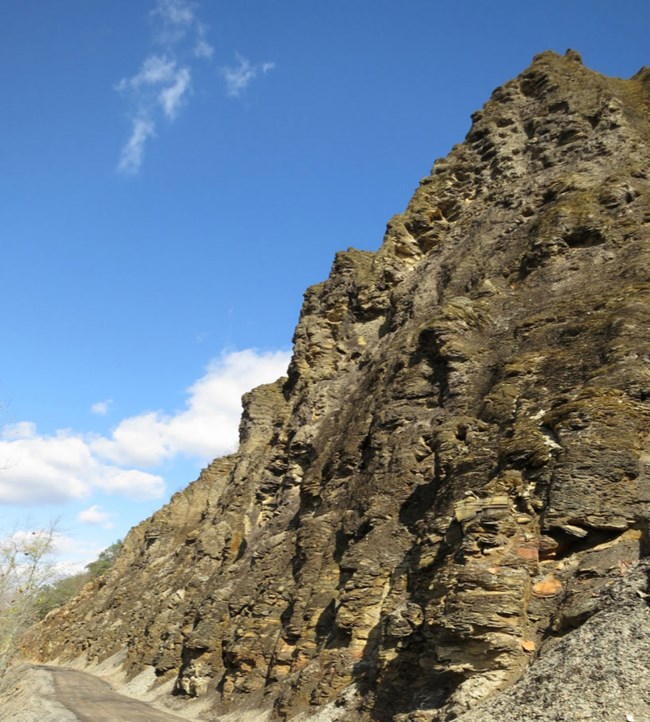Last updated: July 5, 2024
Article
NPS Geodiversity Atlas—Hopewell Culture National Historical Park, Ohio
Geodiversity refers to the full variety of natural geologic (rocks, minerals, sediments, fossils, landforms, and physical processes) and soil resources and processes that occur in the park. A product of the Geologic Resources Inventory, the NPS Geodiversity Atlas delivers information in support of education, Geoconservation, and integrated management of living (biotic) and non-living (abiotic) components of the ecosystem.

Introduction
Hopewell Culture National Historical Park (HOCU) is composed of a series of prehistoric mound sites that surround the city of Chillicothe in Ross County, south-central Ohio. Originally proclaimed as Mound City Group National Monument on March 2, 1923, the park unit was renamed and redesignated a national historical park on May 27, 1992. HOCU contains approximately 740 hectares (1,828 acres) distributed amongst six separate park sites: (1) Mound City Group; (2) Hopewell Mound Group; (3) Seip Earthworks; (4) Hopeton Earthworks; (5) High Bank Works; and (6) Spruce Hill Works. The national historical park was established to preserve the earthworks of the prehistoric Hopewell culture, which occupied the Ohio River Valley from about 200 B.C.E. to 500 C.E. (National Park Service 2017b). The term “Hopewell” encompasses a broad network of cultural beliefs and practices shared among different Native American groups across a large area of eastern North America. Prehistoric sites of the Hopewell are characterized by earthworks and mound complexes often constructed in various geometric forms of various sizes that can reach up to 9 m (30 ft) high and more than 305 m (1,000 ft) across (National Park Service 2016a). The national historic site contains the highest concentration of Hopewell earthworks in the country, and offers insight into the cultural, social, and spiritual practices that were distinctive and widespread for more than 700 years.
Geologic Setting
Hopewell Culture National Historical Park is situated along the boundary between the Central Lowland and Appalachian Plateaus physiographic provinces, just south of the Allegheny Escarpment in the Glaciated Allegheny Plateaus section. The region of HOCU marks the maximum extent of two major Pleistocene glacial advances (Illinoian and Wisconsinan stages) in Ohio. Geologic units mapped within and surrounding HOCU can be divided into three main categories: (1) Paleozoic sedimentary rocks; (2) Quaternary deposits from the Illinoian and Wisconsinan glacial periods; and (3) late Pleistocene–Holocene fluvial deposits associated with stream channels dating to the past 17,000 years (ThornberryEhrlich 2013b). The oldest Paleozoic strata in HOCU consists of undifferentiated Silurian rocks of the Tymochtee Dolomite, Greenfield Dolomite, Peebles Dolomite, Lilly Formation, and Bisher Formation that underlie a significant portion of the Seip Earthworks. The Devonian Ohio Shale and Olentangy Shale are widely mapped across each park site at HOCU. Present at the Spruce Hill Earthworks are younger Devonian (Sunbury Shale, Berea Sandstone, and Bedford Shale) and Mississippian (Logan and Cuyahoga Formations) rocks that form and cap Spruce Hill. Pleistocene ice age deposits blanket much of the bedrock at HOCU and serve as the foundation upon which the peoples of the Hopewell culture built their mounds. More specifically, the earthworks are constructed on glacial outwash terraces adjacent to rivers and streams.
Regional Geology
Hopewell Culture National Historical Park is a part of the Central Lowland Physiographic Province and shares its geologic history and some characteristic geologic formations with a region that extends well beyond park boundaries.
- Scoping summaries are records of scoping meetings where NPS staff and local geologists determined the park’s geologic mapping plan and what content should be included in the report.
- Digital geologic maps include files for viewing in GIS software, a guide to using the data, and a document with ancillary map information. Newer products also include data viewable in Google Earth and online map services.
- Reports use the maps to discuss the park’s setting and significance, notable geologic features and processes, geologic resource management issues, and geologic history.
- Posters are a static view of the GIS data in PDF format. Newer posters include aerial imagery or shaded relief and other park information. They are also included with the reports.
- Projects list basic information about the program and all products available for a park.
Source: NPS DataStore Saved Search 2899. To search for additional information, visit the NPS DataStore.
A NPS Soil Resources Inventory project has been completed for Hopewell Culture National Historical Park and can be found on the NPS Data Store.
Source: NPS DataStore Saved Search 2970. To search for additional information, visit the NPS DataStore.

Related Links

